Do you have aspirations of journaling more? Me too. Of getting more organized and being able to cross more to-dos off your list? Ditto.
While finding just the right journal or system isn’t always the answer, sometimes it can give you the nudge you need.
That’s where the Bullet Journal comes in. If you’re a web surfer in any regard, you’ve likely seen that term pop up now and again as a new method of journaling that combines a traditional diary with calendaring, to-dos, capturing ideas, etc. While you can buy an official branded Bullet Journal, you can also create the template yourself using just about any notebook. Many people prefer a dot grid layout to lined (for doodling and adding more creative flare), but it’s certainly not a requirement.
While there’s an entire book on how to “properly” use the Bullet Journal methodology, it’s an easy system to learn with just a few pointers.
Below you’ll find why I enjoy it and some fundamental tips that make the Bullet Journal a uniquely useful tool.
What Is a Bullet Journal?
Here are a few features that make the Bullet Journal unique among other journaling systems (plenty more on all of these below):
- Starts with an index. At the very start of the journal is a detailed index with page numbers so that everything in the journal is easily findable.
- Includes monthly/daily logs for planning, productivity, note-taking, and journaling.
- Makes use of various bullet points within those logs in order to signify tasks (and if those tasks are done, delegated, incomplete, etc.), events, ideas, and more. Hence the name “Bullet Journal.”
- Includes any number of “Collections” — pages that center on various subjects and which function for any purpose you’d like, from book lists to workout/food tracking to idea capture and more.
That’s a rough idea of what comprises a Bullet Journal. Next, a few reasons why I and many others utilize this system.
A Few Benefits of the Bullet Journal
Works with other journaling/to-do systems. Part of why I enjoy the Bullet Journal is that it can be combined with a number of other journaling and productivity systems. Want to do our 31-day Jumpstart Your Journaling Challenge? No problem; make it part of your Bullet Journal. Curious about trying the Rule of 3? Ditto.
Combines lists/notebooks into a single “file.” I used to have a number of different notebooks for varying purposes — journal, to-do list, book log and notes, etc. I appreciate that the Bullet Journal keeps it all in one place.
Organizes your jottings. The journal’s index allows you to keep all the different kinds of logs and notes you compile within its covers well-organized and easy to track.
Totally customizable. I know a lot of people who use a form of the Bullet Journal, and each puts their own spin on it: some use an index and subject-based pages without utilizing it as a productivity tool; others use it only for productivity and still keep a traditional journal elsewhere. It’s a methodology that really works for you. Read the guide below and take my suggestions, but not too seriously. Experiment with it, and be sure it’s a system you enjoy and find useful. Otherwise, what’s the point?
How to Make and Use a Bullet Journal
Number Your Pages
Task number one for creating your Bullet Journal is to number your pages. Since everything gets indexed, that’s pretty crucial. This methodology has become popular enough that many of the journals you can buy today already have pages numbered (and some even have a couple pages preset for an index at the front).
The Index
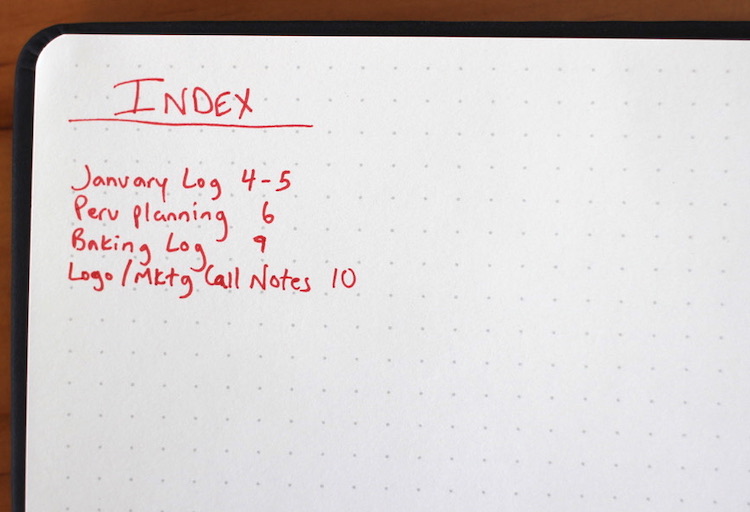
The first few pages of a Bullet Journal are given to an index. Here, you’ll log the subjects and page numbers for everything that ends up in the journal. From monthly/daily logs to various lists, ideas, and traditional diary-like entries.
The index is the roadmap of this journal. It’s how you quickly figure out where everything is; as long as new pages are logged into the index, you’ll stay pretty well organized.
While it won’t be filled in much right away, you’ll add to it frequently, perhaps even daily.
So on page 1, start your index. You’ll list subjects, or “Collections” in Bullet Journal parlance, and follow it with the page number(s). Some categories will be contained within just a single page; others will be added to over time; “Book Lists” could end up on pages 10, 24, 32, etc.
Set aside a couple pages for your index.
Monthly Logs

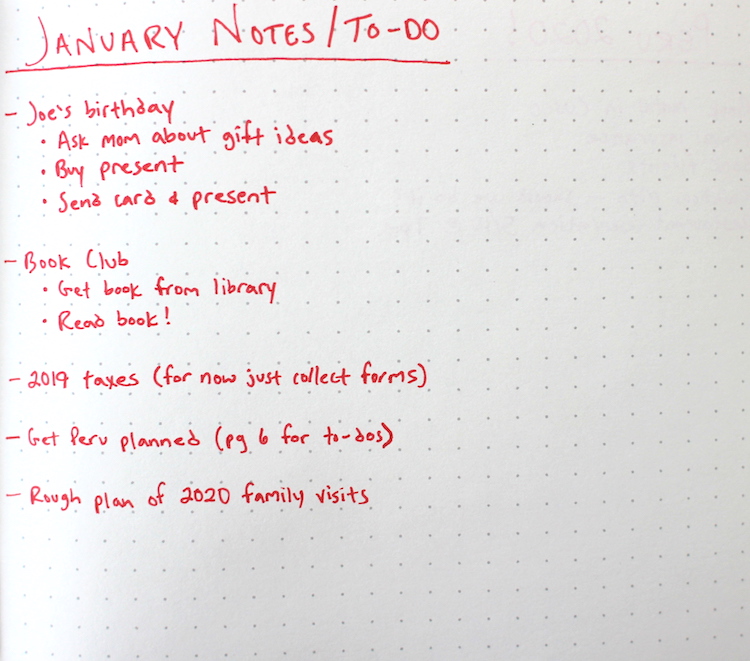
For the monthly log to-dos, I keep everything as just a dash on the first level, then break it down further.
Each month, you’ll create a 2-page log to track events and to-dos from cruising altitude. On the first page of the log, jot down the date on the left side. (I put a line marking new weeks as well.) From here, you can mark major upcoming events and due dates. Later, you can also use this space to mark events you want to remember (a good date night, running into an old friend, a promotion); it’s both looking into the future and cataloging the past.
On the second page of the monthly log, jot down the major to-dos and even goals you have (broken down into smaller steps, or with a page number for where those smaller steps reside). The list can be added to over time, and you can also add projects to it after the fact as a way of tracking productivity.
While you could set aside pages for each month of the year at the start of the journal, I prefer doing it as I go; when you start a new Bullet Journal you don’t really know how long it’s going to last you before you need a new notebook. So while Month One (whichever month you’re starting in!) will be at the start, the next month might be on page 20 or 50 or whatever.
Of course, mark these in the index! “January Log — pg 5”.
Daily Logs
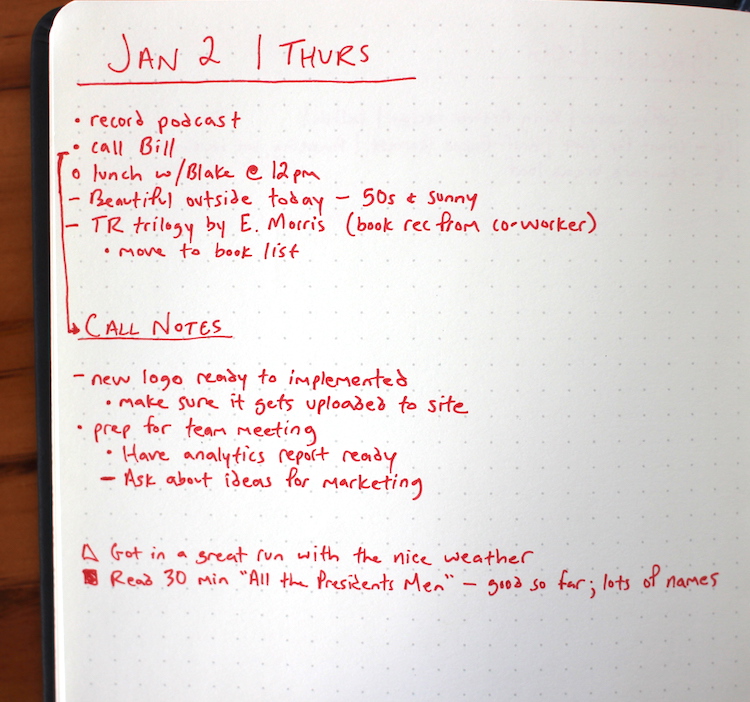
I like to give each day its own full page in my Bullet Journal. You sure don’t have to, but I do. Here, you’ll write down important to-dos (Rule of 3, perhaps), events (lunch meeting/date, calls, parties, etc.), and any notes you want to remember from that day; these can be short diary-like entries — a random note about the crazy snow storm, the Vikings big playoff win — or business/project notes and ideas. There’s no limit really. Use the daily log to capture everything from that day.
Just as with the monthly logs, I don’t set aside a number of pages at the start for daily logs. I just go to the next page that’s available; sometimes daily logs take up a few pages in a row, and sometimes there are other pages between that serve various purposes.
Since daily logs are so frequent, they don’t necessarily need a place in the index. Anything that’s important or needs remembering for later can be transferred into other collections. However, if there’s some chunk that’s especially important (like meeting notes), then feel free to mark it in the index.
Other Categories/Collections

While the monthly and daily logs could basically make up the entirety of your Bullet Journal (and for some people they do), it’s likely you’ll want other pages to exist as gatherers of other pertinent or creative information.
A small sampling of ideas:
- Book lists — books read (with ratings!), books to read, quotes from books that you really like.
- Travel planning — as in the photo example above, the Bullet method is great for planning your trips.
- Ideas — if you partake in any creative endeavor or hobby, collect your ideas in one spot.
- Hobbies — this is the real fun of the Bullet Journal, in my opinion. I have a baking log where I track the recipes I’ve tried (and another list with recipes I want to try out). I have a coffee log where I track my coffee roasting with notes on the flavors. Tailor to your own hobbies!
- Fitness — whether you’re a runner or a lifter or a recreational basketball player, track your activity to see how your performance is improving or plateauing (also, it’s just kind of fun).
- Gift ideas — never lose a great gift idea again. Have a page for each side of the family.
- Food Logs — recipes made (with star ratings!), food consumed (track your macros analog-style!), water intake, etc.
- Strenuous Life tracking — if you’re a TSL member, track your badge work, Agon completions, etc. It can all be done online, but it’s fun to track some of it on paper too, especially as you’re coming up with action plans for completing badges and what not.
- Diary — if you’re looking for more of a daily standard journal entry, you can combine it with your daily log, but you don’t have to; you can certainly create sections just for recording thoughts/feelings and journaling prompts.
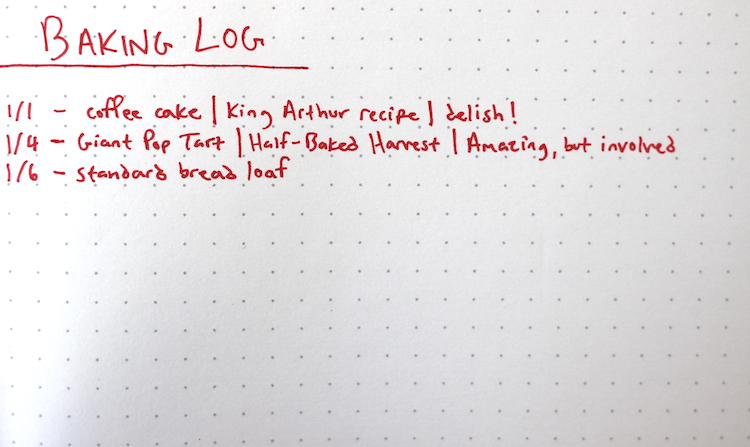
These collection pages go right in the mix of the monthly/daily logs on the next open page that’s available. Even for things that I know may take up more than one page, I only ever give a single page to start with. As long as it’s indexed, I don’t personally care if topics are always grouped together; my baking log might start on page 9 but then continue a few months later on page 50.
Bullets
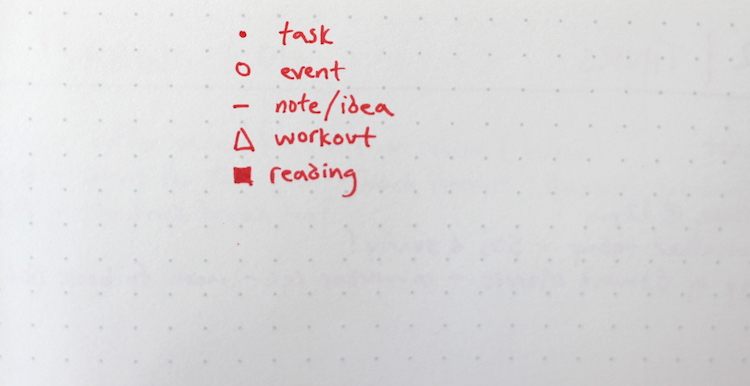
The Bullet Journal methodology creatively employs the use of various bullet points.
While they’re mostly used within the monthly and daily logs, they can be used elsewhere too, depending on your goals and hopes for the journal.

In your monthly and daily log (but particularly in the latter), each thing you’ll write will be marked with a unique bullet point. There are five primary types that I use:
- Standard bullets — a to-do item; a task to perform. There are then a number of “signifiers” you can add to these bullets to mark various stages of completion:
- An “X” marks the task as complete.
- A single diagonal line (half an “X”) marks the task as halfway completed; these tasks are generally moved into the next day.
- An arrow means the task has been moved either to a different day, or perhaps delegated to another person (which can be noted); this signifier just depends on how you want to use the journal.
- A task that’s crossed out no longer needs doing.
- Dash — a note that isn’t connected to a to-do item; anything random you want to remember; diary-like entries; ideas; observations.
- Open circle — events; noteworthy moments in time you’d like to remember, either upcoming or that happened in the past; used primarily just to record experiences, though I often connect them to notes and tasks when applicable.
- Make up your own! I use a triangle to mark a workout and a filled-in square to note the day’s reading. I’m not much of an artist, but you can use more creative bullets to track or denote various other things.
One of the keys to the effectiveness of these bullets is using nesting. Many tasks, especially in project form, require sub-tasks; upcoming events often have notes/tasks connected to them; past events (a meeting you just finished) often end with to-dos and notes.
These various bullet markings are nested and mixed and matched throughout your logs, making it a breeze to combine to-do lists with calendaring with journaling. This is why I personally enjoy the Bullet Journal. I want my daily jottings and ideas and even book notes to turn into actionable items. I don’t want them to just end up as a filled up journal that’s then stashed away in my closet never to be seen again — of which I have plenty.
Migrating — The 10/15 Principle
Charlie Gilkey, in his book Start Finishing (and also in his interview with Brett), brought to my attention the idea of the “10/15 principle.”
Give 10 minutes at the end of each day to review your monthly and daily logs — are there any random notes that should be migrated into a collection? For example, a coworker gave you a book recommendation, which you jotted into the daily log, and at the end of the day you migrate it over to the Books Recs list you’ve already started. You could, of course, just immediately jot it down into that book list, but part of what I like about the Bullet Journal method is putting everything from a day into one spot and not worrying about organizing it in the moment. You don’t have to worry about flipping pages or getting distracted by your various lists and ideas — keep a bookmark on the day’s log and organize at the end of the day.
If you jotted some ideas down about a freelance project or a hobby, migrate them to the corresponding collection.
If there were to-dos that didn’t get accomplished, start the next day’s log and put them in there, as well as any events that need inputting. Of course this doesn’t replace a calendar, but gives your day a little more of a visual flow that incorporates both events and to-dos.
Then, give 15 minutes at the start of the next day to plan, review your goal lists, give your monthly log a quick scan, perhaps set your Rule of 3, and hit the ground running.
At the end of each month, do the same thing, but on a larger scale and with slightly more time given to the task.
The review is important because it’s what ensures things don’t get lost in your notebook. As I’ve alluded to, that’s what tends to be my problem with standard journaling — I’ll jot down ideas and things I don’t want to forget, and then promptly just keep turning the pages and never have any clue of where said idea went. With the Bullet Journal, you get things written down, indexed, and if done correctly, acted upon.
Putting It All Together — A Quick Recap
I know this may seem like a lot of organizational ideas thrown your way at once, so here’s a quick recap:
- Put an index at the start of your notebook or journal which captures the page numbers for everything being written down.
- Create a monthly log to get a broad overview of the big events/to-dos/goals for each month.
- Create a daily log to do the same thing on a smaller scale.
- Use the various bullets and signifiers to jot down to-dos, events, notes, etc.
- Use short daily planning and review sessions to migrate notes, to-dos, and ideas so that they don’t get lost in the jungle of a well-filled notebook.








